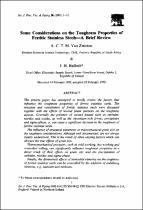 ResearchSpace
ResearchSpace
Some considerations on the toughness properties of ferritic stainless steels - A brief review
JavaScript is disabled for your browser. Some features of this site may not work without it.
- ResearchSpace
- →
- Research Publications/Outputs
- →
- Journal Articles
- →
- View Item
| dc.contributor.author |
Van Zwieten, ACTM

|
en_US |
| dc.contributor.author |
Bulloch, JH

|
en_US |
| dc.date.accessioned | 2007-02-06T08:43:24Z | en_US |
| dc.date.accessioned | 2007-06-07T10:06:04Z | |
| dc.date.available | 2007-02-06T08:43:24Z | en_US |
| dc.date.available | 2007-06-07T10:06:04Z | |
| dc.date.copyright | en_US | |
| dc.date.issued | 1993-02 | en_US |
| dc.identifier.citation | Van Zwieten, ACTM and Bulloch, JH. 1993. Some considerations on the toughness properties of ferritic stainless steels - A brief review. International journal of pressure vessels and piping, vol 56(1), pp 1-31 | en_US |
| dc.identifier.issn | 0308-0161 | en_US |
| dc.identifier.uri | http://hdl.handle.net/10204/1477 | en_US |
| dc.identifier.uri | http://hdl.handle.net/10204/1477 | |
| dc.description.abstract | The present paper has attempted to briefly review the factors that influence the toughness properties of ferritic stainless steels. The structure and constitution of ferritic stainless steels were discussed together with the effects of second phase particles on the toughness aspects. Generally the presence of second phases such as carbides, nitrides and oxides, as well as the chromium-rich ferrite, precipitates and sigma-phase, sigma, can cause a significant decrease in the toughness of ferritic stainless steels. The influence of structural parameter or micro structural grain size on the toughness considerations, although well documented, is not always clearly understood. This is the result of other varying factors which can obscure the true effects of grain size. Thermo mechanical processes, such as cold working, hot working and controlled rolling, can significantly influence toughness properties as a direct result of their effects on grain size and the precipitation of carbides, nitrides and sigma-phase. Finally, the detrimental effects of interstitial elements on the toughness of ferritic stainless steels can be controlled by the addition of stabilizing elements, e.g. titanium and niobium. | en_US |
| dc.format.extent | 1394979 bytes | en_US |
| dc.format.mimetype | application/pdf | en_US |
| dc.language.iso | en | en_US |
| dc.publisher | Elsevier Science Ltd | en_US |
| dc.rights | Copyright: 1993 Elsevier Science Ltd | en_US |
| dc.source | en_US | |
| dc.subject | Ferritic stainless steels | en_US |
| dc.subject | Embrittling effects | en_US |
| dc.subject | Iron-chromium allays | en_US |
| dc.subject | Thermo mechanical processing | en_US |
| dc.subject | Microstructural grain sizes | en_US |
| dc.title | Some considerations on the toughness properties of ferritic stainless steels - A brief review | en_US |
| dc.type | Article | en_US |
| dc.identifier.apacitation | Van Zwieten, A., & Bulloch, J. (1993). Some considerations on the toughness properties of ferritic stainless steels - A brief review. http://hdl.handle.net/10204/1477 | en_ZA |
| dc.identifier.chicagocitation | Van Zwieten, ACTM, and JH Bulloch "Some considerations on the toughness properties of ferritic stainless steels - A brief review." (1993) http://hdl.handle.net/10204/1477 | en_ZA |
| dc.identifier.vancouvercitation | Van Zwieten A, Bulloch J. Some considerations on the toughness properties of ferritic stainless steels - A brief review. 1993; http://hdl.handle.net/10204/1477. | en_ZA |
| dc.identifier.ris | TY - Article AU - Van Zwieten, ACTM AU - Bulloch, JH AB - The present paper has attempted to briefly review the factors that influence the toughness properties of ferritic stainless steels. The structure and constitution of ferritic stainless steels were discussed together with the effects of second phase particles on the toughness aspects. Generally the presence of second phases such as carbides, nitrides and oxides, as well as the chromium-rich ferrite, precipitates and sigma-phase, sigma, can cause a significant decrease in the toughness of ferritic stainless steels. The influence of structural parameter or micro structural grain size on the toughness considerations, although well documented, is not always clearly understood. This is the result of other varying factors which can obscure the true effects of grain size. Thermo mechanical processes, such as cold working, hot working and controlled rolling, can significantly influence toughness properties as a direct result of their effects on grain size and the precipitation of carbides, nitrides and sigma-phase. Finally, the detrimental effects of interstitial elements on the toughness of ferritic stainless steels can be controlled by the addition of stabilizing elements, e.g. titanium and niobium. DA - 1993-02 DB - ResearchSpace DP - CSIR KW - Ferritic stainless steels KW - Embrittling effects KW - Iron-chromium allays KW - Thermo mechanical processing KW - Microstructural grain sizes LK - https://researchspace.csir.co.za PY - 1993 SM - 0308-0161 T1 - Some considerations on the toughness properties of ferritic stainless steels - A brief review TI - Some considerations on the toughness properties of ferritic stainless steels - A brief review UR - http://hdl.handle.net/10204/1477 ER - | en_ZA |





